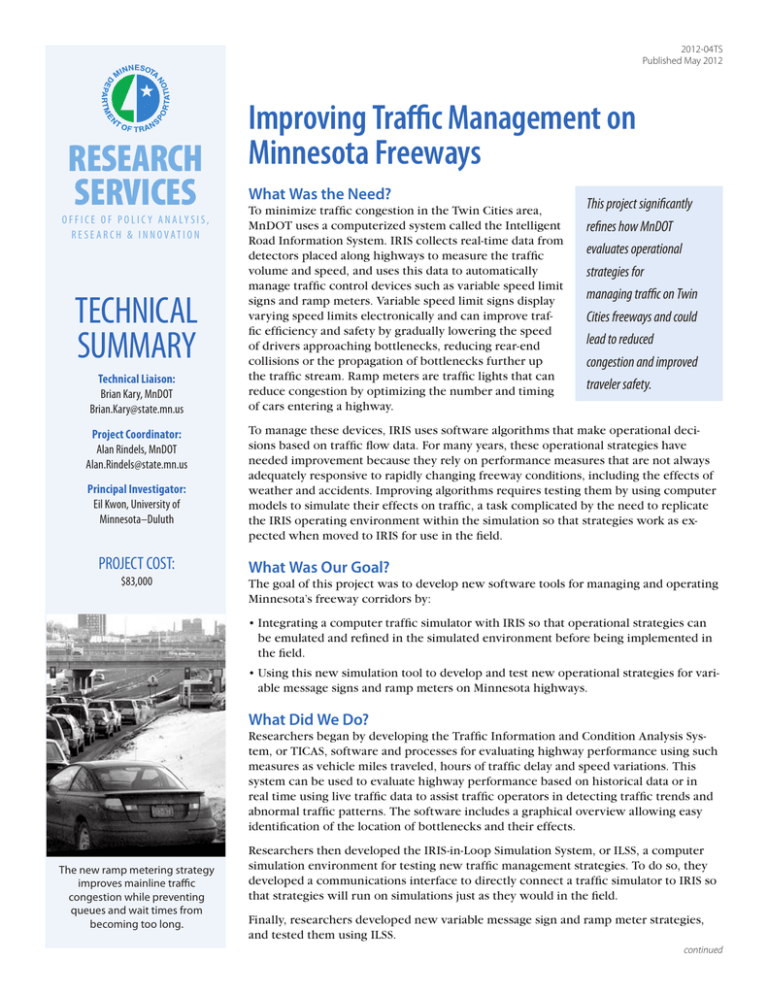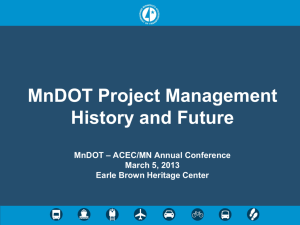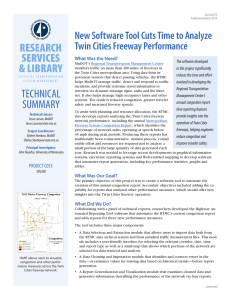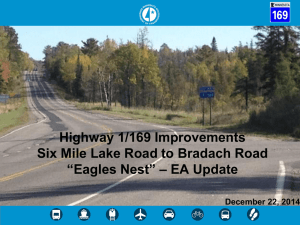RESEARCH SERVICES Improving Traffic Management on Minnesota Freeways
advertisement

2012-04TS Published May 2012 RESEARCH SERVICES O F F I C E O F P O L I C Y A N A LY S I S , R E SE A R C H & I N N OVAT I O N TECHNICAL SUMMARY Technical Liaison: Brian Kary, MnDOT Brian.Kary@state.mn.us Project Coordinator: Alan Rindels, MnDOT Alan.Rindels@state.mn.us Principal Investigator: Eil Kwon, University of Minnesota–Duluth PROJECT COST: $83,000 Improving Traffic Management on Minnesota Freeways What Was the Need? To minimize traffic congestion in the Twin Cities area, MnDOT uses a computerized system called the Intelligent Road Information System. IRIS collects real-time data from detectors placed along highways to measure the traffic volume and speed, and uses this data to automatically manage traffic control devices such as variable speed limit signs and ramp meters. Variable speed limit signs display varying speed limits electronically and can improve traffic efficiency and safety by gradually lowering the speed of drivers approaching bottlenecks, reducing rear-end collisions or the propagation of bottlenecks further up the traffic stream. Ramp meters are traffic lights that can reduce congestion by optimizing the number and timing of cars entering a highway. This project significantly refines how MnDOT evaluates operational strategies for managing traffic on Twin Cities freeways and could lead to reduced congestion and improved traveler safety. To manage these devices, IRIS uses software algorithms that make operational decisions based on traffic flow data. For many years, these operational strategies have needed improvement because they rely on performance measures that are not always adequately responsive to rapidly changing freeway conditions, including the effects of weather and accidents. Improving algorithms requires testing them by using computer models to simulate their effects on traffic, a task complicated by the need to replicate the IRIS operating environment within the simulation so that strategies work as expected when moved to IRIS for use in the field. What Was Our Goal? The goal of this project was to develop new software tools for managing and operating Minnesota’s freeway corridors by: • Integrating a computer traffic simulator with IRIS so that operational strategies can be emulated and refined in the simulated environment before being implemented in the field. • Using this new simulation tool to develop and test new operational strategies for variable message signs and ramp meters on Minnesota highways. What Did We Do? Researchers began by developing the Traffic Information and Condition Analysis System, or TICAS, software and processes for evaluating highway performance using such measures as vehicle miles traveled, hours of traffic delay and speed variations. This system can be used to evaluate highway performance based on historical data or in real time using live traffic data to assist traffic operators in detecting traffic trends and abnormal traffic patterns. The software includes a graphical overview allowing easy identification of the location of bottlenecks and their effects. The new ramp metering strategy improves mainline traffic congestion while preventing queues and wait times from becoming too long. Researchers then developed the IRIS-in-Loop Simulation System, or ILSS, a computer simulation environment for testing new traffic management strategies. To do so, they developed a communications interface to directly connect a traffic simulator to IRIS so that strategies will run on simulations just as they would in the field. Finally, researchers developed new variable message sign and ramp meter strategies, and tested them using ILSS. continued “Evaluating the performance of our highways used to be a time-consuming process. Now it takes a couple of mouse clicks, and staff can devote their time to other duties.” —Brian Kary, Freeway Operations Engineer, MnDOT Regional Transportation Management Center Traffic system operators can use TICAS to visualize a highway system’s performance as in this contour plot of average vehicle speeds over time for various freeway corridors. “The new operational strategies developed in this project could substantially reduce congestion and improve safety on the Twin Cities freeway network.” —Eil Kwon, Professor, University of Minnesota–Duluth Department of Civil Engineering What Did We Learn? TICAS improves the way MnDOT measures the performance of its freeway network, enabling more effective real-time traffic management, with continuous refinements to ramp metering, incident management and travel time information systems. ILSS will help MnDOT evaluate new operational strategies by accurately simulating them so they can be evaluated with TICAS’ new performance measures. The new variable speed limit strategy developed by researchers first identifies the locations of the bottlenecks by examining deceleration rates between two detector stations in a given corridor. It then calculates advisory speed limits by using a constant deceleration, which was determined to result in a minimum increase in travel times for drivers. An evaluation of this strategy with ILSS shows that it could significantly reduce sudden deceleration of traffic reacting to bottlenecks while keeping travel time increases relatively small. The new ramp metering strategy is based on corridor density instead of volume since traditional volume-based methods do not take into account the way traffic is affected by narrow lanes and shoulders. The algorithm identifies bottlenecks every 30 seconds and is designed to prevent wait times from becoming too long and causing queues to extend for long distances into surface streets and intersections. A simulation with ILSS on two corridors showed that this strategy substantially reduces congestion travel delays while achieving the same total vehicle miles traveled. What’s Next? Produced by CTC & Associates for: Minnesota Department of Transportation Research Services MS 330, First Floor 395 John Ireland Blvd. St. Paul, MN 55155-1899 (651) 366-3780 www.research.dot.state.mn.us A second phase of this project is already under way to analyze the effects of the new variable speed limit strategy on a segment of I-35W in Minnesota. Researchers will also conduct a field trial of the new ramp metering strategy in the spring of 2012. Using the field trials results, researchers will enhance these strategies to reduce bottleneck identification time and incorporate weather conditions, and then expand them to other corridors. Researchers also recommend further refinement of performance measures to improve the real-time prediction of congestion problems so that operators can respond proactively. This Technical Summary pertains to Report 2012-04, “Development of Freeway Operational Strategies with IRIS-in-Loop Simulation,” published January 2012. The full report can be accessed at http://www.lrrb.org/PDF/201204.pdf.





